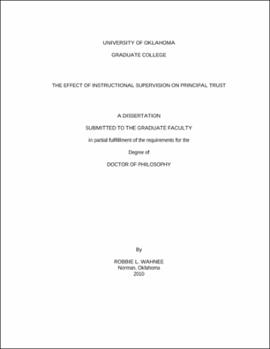| dc.contributor.advisor | Adams, Curt||Maiden, Jeffrey | |
| dc.creator | Wahnee, Robbie | |
| dc.date.accessioned | 2019-05-01T17:22:34Z | |
| dc.date.available | 2019-05-01T17:22:34Z | |
| dc.date.issued | 2010 | |
| dc.identifier | 99105153502042 | |
| dc.identifier.uri | https://hdl.handle.net/11244/319395 | |
| dc.description.abstract | Within-school climates and culture are predicated on organizational structures, distributions of power, and roles that are highly interactive. Hierarchical structures and uneven power distributions, primarily those of teacher-principal, have been found to challenge levels of trust. School interaction patterns form the basis of much of the school literature. With this premise in mind, the purpose of this study was to examine if instructional supervision behaviors of principals have an effect on teachers' perceptions of the principal's trustworthiness. | |
| dc.description.abstract | Drawing from the instructional supervision literature (Blase & Blase, 1999), a ten-item survey instrument was designed to capture principal direct assistance behaviors in his or her role as an instructional supervisor. Specifically, direct assistance was defined as principal-teacher interactions that promote reflective practice and professional growth (Blase & Blase, 1999). The ten-item survey instrument was assessed by submitting it to an exploratory factor analysis. Concurrent validity was performed through correlational analysis using Enabling School Structure (ESS) (Hoy & Sweetland, 2001) as a control variable. Reliability of the instructional supervision scale was estimated using Cronbach's alpha. | |
| dc.description.abstract | Principal trust was defined as a teacher's willingness to be vulnerable based on the confidence that the principal is benevolent, reliable, competent, honest, and open (Hoy & Tschannen-Moran, 1999, 2000). 258 teachers in a large, Midwestern, | |
| dc.description.abstract | urban elementary school district participated in the online survey. Multilevel modeling was utilized to partition variance in principal trust, the dependent variable, to individual and school factors, as well as to explain variation by individual characteristics. Intraclass Correlation Coefficients (ICC) for principal trust, instructional supervision, and enabling school structure indicated that between-school variability for each construct was significant. The results of the instructional supervision measure indicated that of the variables tested, instructional supervision was the strongest predictor of principal trust. Instructional supervision, alone, explained nearly 98 percent of the between-school variability in principal trust. Teacher perceptions of the principal's direct instructional assistance strongly influence principal trust. This research suggests that instructional supervision is an important component of a healthy, well-functioning school. Implications for future research are significant for a principal's leadership role that should include well-defined direct assistance to teachers. A focus on the core function of instructional supervision aimed at improved teacher learning and development should be advocated in schools. Those principals who are accomplished, as demonstrated in this research, and whose teachers have high principal trust can be the model that others emulate. This study defines one mechanism in instructional supervision that can now provide a framework for further study. | |
| dc.format.extent | 170 pages | |
| dc.format.medium | application.pdf | |
| dc.language | en_US | |
| dc.relation.requires | Adobe Acrobat Reader | |
| dc.subject | Teacher-principal relationships | |
| dc.subject | School supervision | |
| dc.subject | Trust | |
| dc.title | THE EFFECT OF INSTRUCTIONAL SUPERVISION ON PRINCIPAL TRUST | |
| dc.type | text | |
| dc.type | document | |
| dc.thesis.degree | Ph.D. | |
| ou.group | Jeannine Rainbolt College of Education::Department of Educational Leadership and Policy Studies | |
